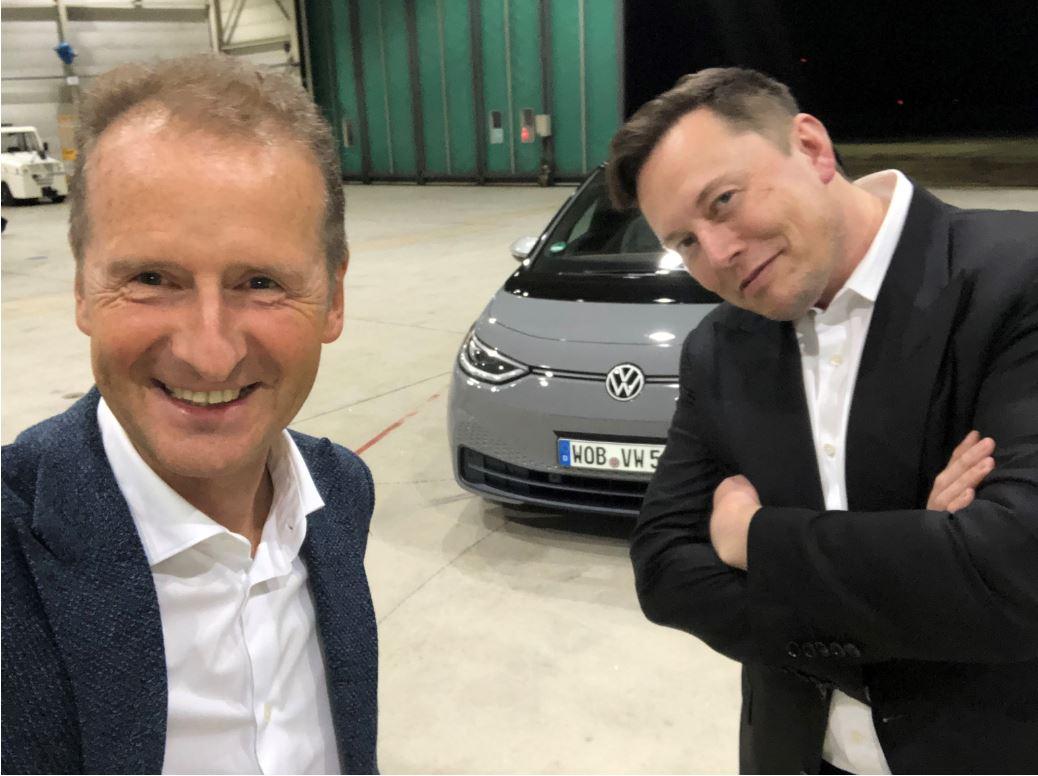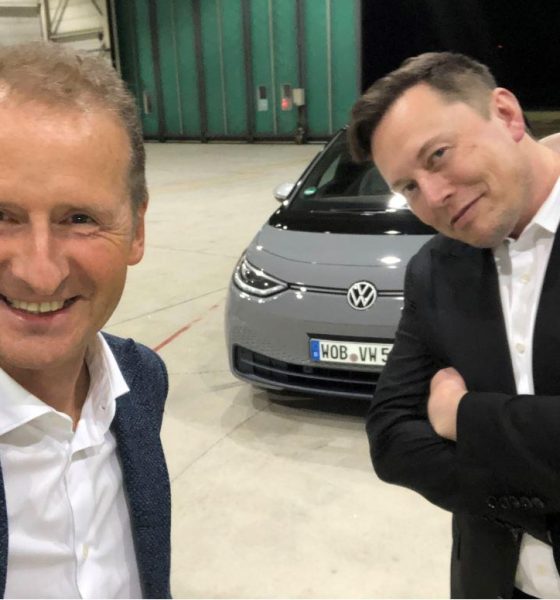

News
Tesla Battery Day vs. Volkswagen Power Day: How Wall Street reacted
Tesla’s Battery Day and Volkswagen’s Power Day were two similar events that showed how the two automakers plan to combat electric vehicle prices within the next few years. Despite the similarities in the events, Wall Street reacted quite differently to both, with Tesla (NASDAQ: TSLA) seeing a minimal effect on its stock in the days following. However, Volkswagen’s stock (OTCMKTS: VWAGY) is soaring over 12% on the day after the event.
Tesla Battery Day
Tesla’s Battery Day was a marquee event for the electric automaker. While the previous year’s focus was Autonomy, 2020 saw battery cells as Tesla’s main concentration. During the event, CEO Elon Musk revealed how Tesla would combat battery prices by continuing to source cells from third-party suppliers, but also by developing its own 4680 cells that are produced by the company in-house. Additionally, new structural battery packs are being used to house the cells and also provide a more robust crash response in the event of an accident. The rigidity of the new structural battery intends to take Tesla’s safety ratings through the roof, where they already reside.
Tesla also revealed plans for a $25,000 car, a blueprint to manufacture 20 million cars per year, and a roadmap to massive cuts in battery cell production costs.
LIVE BLOG: Tesla Battery Day and Annual Shareholder Meeting 2020 updates
Despite the developments, Tesla didn’t receive a big boost on Wall Street. Interestingly, despite the massive developments and plans that Tesla had revealed during the Battery Day event on September 22nd, 2020, the stock closed at $424.23. The day following saw an 11% drop in the stock, as it closed at $380.36.
Many didn’t understand the reason for the drop. Tesla bull and investor Jim Cramer, who was at one time bearish on the automaker’s stock, stated that the stock fell simply because Tesla didn’t announce what some were expecting. “They’re just bummed the things they hyped didn’t happen,” Cramer said. “Tesla rolls out a plan to create an electric car for the masses and greeted with a yawn because Musk didn’t roll out a magic battery. This is what happens when you let expectations get out of control.”
Volkswagen Power Day
Volkswagen’s Power Day was, in effect, the German automaker’s version of Tesla’s Battery Day. The company held an event outlining their plans for cell cost reductions, along with plans for six total production plants across Europe. VW also has established several partnerships with European energy companies to roll out an expansive charging infrastructure, among many other developments.
“We aim to reduce the cost and complexity of the battery and at the same time increase its range and performance,” Volkswagen Group Board Member for Technology Thomas Schmall said. “We will use our economies of scale to the benefit of our customers when it comes to the battery too. On average, we will drive down the cost of battery systems to significantly below €100 per kilowatt-hour. This will finally make e-mobility affordable and the dominant drive technology.”
Volkswagen’s Power Day: Six new cell plants, new unified battery cell, charging network partnerships
Volkswagen stock began Monday’s trading session at $28.38. After the developments that VW announced, the stock shot up $1.38, a boost of 4.86%. However, the German company’s stock is enjoying massive gains today, just one day after the big event. After closing at $29.76 yesterday, VW stock has increased another 3.48% at the time of writing, for a total gain of 11.69% as of 2:30 PM EST.
The differences in the presentations and how Wall Street has responded to them are unknown. However, the sheer size of Volkswagen’s production figures could be the main reason for the increased investor response. While Tesla’s rollout of 500,000 vehicles in 2020 was a company best, Volkswagen delivered 9.3 million vehicles last year. For context, VW has also been around since 1937, while Tesla has only produced a mass-market vehicle since 2017.
Tesla is undoubtedly the leader in electric vehicles. Volkswagen, while still working out software kinks, could be considered second-place by some because of the successful adaptation of the ID. family of vehicles in Europe so far. However, it is still admittedly ironing out some software issues with its MEB platform, and it seems somewhat odd that VW’s stock received such a healthy boost in the day following its Power Day event.
What do you think? What is the reasoning for the substantial difference in Wall Street’s reaction? Let us know in the comments below, or Tweet me directly.
Disclosure: Joey Klender is a TSLA Shareholder.

News
Tesla FSD fleet is nearing 7 billion total miles, including 2.5 billion city miles
As can be seen on Tesla’s official FSD webpage, vehicles equipped with the system have now navigated over 6.99 billion miles.

Tesla’s Full Self-Driving (Supervised) fleet is closing in on almost 7 billion total miles driven, as per data posted by the company on its official FSD webpage.
These figures hint at the massive scale of data fueling Tesla’s rapid FSD improvements, which have been quite notable as of late.
FSD mileage milestones
As can be seen on Tesla’s official FSD webpage, vehicles equipped with the system have now navigated over 6.99 billion miles. Tesla owner and avid FSD tester Whole Mars Catalog also shared a screenshot indicating that from the nearly 7 billion miles traveled by the FSD fleet, more than 2.5 billion miles were driven inside cities.
City miles are particularly valuable for complex urban scenarios like unprotected turns, pedestrian interactions, and traffic lights. This is also the difference-maker for FSD, as only complex solutions, such as Waymo’s self-driving taxis, operate similarly on inner-city streets. And even then, incidents such as the San Francisco blackouts have proven challenging for sensor-rich vehicles like Waymos.
Tesla’s data edge
Tesla has a number of advantages in the autonomous vehicle sector, one of which is the size of its fleet and the number of vehicles training FSD on real-world roads. Tesla’s nearly 7 billion FSD miles then allow the company to roll out updates that make its vehicles behave like they are being driven by experienced drivers, even if they are operating on their own.
So notable are Tesla’s improvements to FSD that NVIDIA Director of Robotics Jim Fan, after experiencing FSD v14, noted that the system is the first AI that passes what he described as a “Physical Turing Test.”
“Despite knowing exactly how robot learning works, I still find it magical watching the steering wheel turn by itself. First it feels surreal, next it becomes routine. Then, like the smartphone, taking it away actively hurts. This is how humanity gets rewired and glued to god-like technologies,” Fan wrote in a post on X.
News
Tesla starts showing how FSD will change lives in Europe
Local officials tested the system on narrow country roads and were impressed by FSD’s smooth, human-like driving, with some calling the service a game-changer for everyday life in areas that are far from urban centers.

Tesla has launched Europe’s first public shuttle service using Full Self-Driving (Supervised) in the rural Eifelkreis Bitburg-Prüm region of Germany, demonstrating how the technology can restore independence and mobility for people who struggle with limited transport options.
Local officials tested the system on narrow country roads and were impressed by FSD’s smooth, human-like driving, with some calling the service a game-changer for everyday life in areas that are far from urban centers.
Officials see real impact on rural residents
Arzfeld Mayor Johannes Kuhl and District Administrator Andreas Kruppert personally tested the Tesla shuttle service. This allowed them to see just how well FSD navigated winding lanes and rural roads confidently. Kruppert said, “Autonomous driving sounds like science fiction to many, but we simply see here that it works totally well in rural regions too.” Kuhl, for his part, also noted that FSD “feels like a very experienced driver.”
The pilot complements the area’s “Citizen Bus” program, which provides on-demand rides for elderly residents who can no longer drive themselves. Tesla Europe shared a video of a demonstration of the service, highlighting how FSD gives people their freedom back, even in places where public transport is not as prevalent.
What the Ministry for Economic Affairs and Transport says
Rhineland-Palatinate’s Minister Daniela Schmitt supported the project, praising the collaboration that made this “first of its kind in Europe” possible. As per the ministry, the rural rollout for the service shows FSD’s potential beyond major cities, and it delivers tangible benefits like grocery runs, doctor visits, and social connections for isolated residents.
“Reliable and flexible mobility is especially vital in rural areas. With the launch of a shuttle service using self-driving vehicles (FSD supervised) by Tesla in the Eifelkreis Bitburg-Prüm, an innovative pilot project is now getting underway that complements local community bus services. It is the first project of its kind in Europe.
“The result is a real gain for rural mobility: greater accessibility, more flexibility and tangible benefits for everyday life. A strong signal for innovation, cooperation and future-oriented mobility beyond urban centers,” the ministry wrote in a LinkedIn post.
News
Tesla China quietly posts Robotaxi-related job listing
Tesla China is currently seeking a Low Voltage Electrical Engineer to work on circuit board design for the company’s autonomous vehicles.

Tesla has posted a new job listing in Shanghai explicitly tied to its Robotaxi program, fueling speculation that the company is preparing to launch its dedicated autonomous ride-hailing service in China.
As noted in the listing, Tesla China is currently seeking a Low Voltage Electrical Engineer to work on circuit board design for the company’s autonomous vehicles.
Robotaxi-specific role
The listing, which was shared on social media platform X by industry watcher @tslaming, suggested that Tesla China is looking to fill the role urgently. The job listing itself specifically mentions that the person hired for the role will be working on the Low Voltage Hardware team, which would design the circuit boards that would serve as the nervous system of the Robotaxi.
Key tasks for the role, as indicated in the job listing, include collaboration with PCB layout, firmware, mechanical, program management, and validation teams, among other responsibilities. The role is based in Shanghai.
China Robotaxi launch
China represents a massive potential market for robotaxis, with its dense urban centers and supportive policies in select cities. Tesla has limited permission to roll out FSD in the country, though despite this, its vehicles have been hailed as among the best in the market when it comes to autonomous features. So far, at least, it appears that China supports Tesla’s FSD and Robotaxi rollout.
This was hinted at in November, when Tesla brought the Cybercab to the 8th China International Import Expo (CIIE) in Shanghai, marking the first time that the autonomous two-seater was brought to the Asia-Pacific region. The vehicle, despite not having a release date in China, received a significant amount of interest among the event’s attendees.








